
I think everyone knows that I have lived with Multiple Sclerosis for over 20 years now. Of course, this does cause me to experience pain daily, but I have come to expect it and it does not force me to stop living my life. However, something I have experienced since I was a child is headaches. For the most part, none of the pain caused by MS will keep me in bed for hours or days, but head pain whether it is a headache, or migraine will put me in the bed with an ice pack on my headache for at least hours and sometimes even a few days. These are not easy to handle, but it was a lot worse as a little girl because I would get off the school bus and not move from the couch until the following day.

This is the post that I started research on over a week ago and was not able to complete it until now due to a headache that lasted six days. It is a little ironic that I could not finish a post about headaches due to a headache, but I guess it is what it is. Please remember that I am not a doctor or medical professional in any way, but the information provided in this post is from both my personal experiences and extended research.
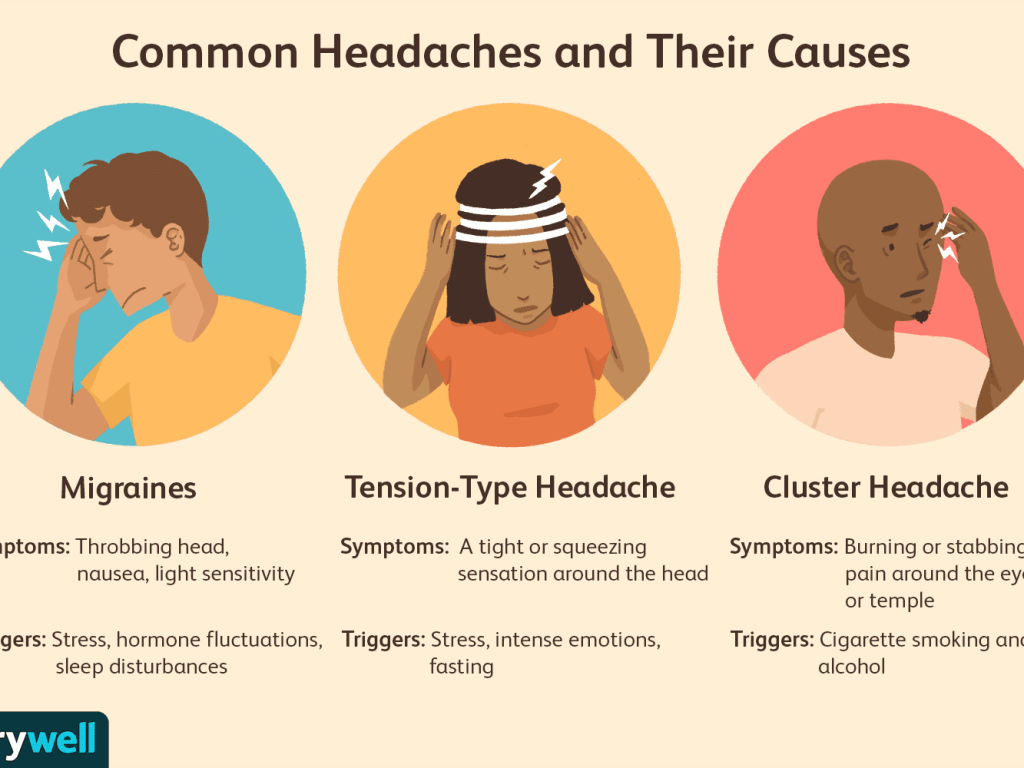
Unfortunately, I am sure everyone around the world is familiar with some type of throbbing, uncomfortable, excruciating, and or distracting pain caused by a headache. Even though many of us have experienced this at some point in our life, it can be difficult to understand and know what kind of headache we are enduring. Some people do not know there are several different types of headaches. Honestly, even after dealing with headaches since I was a child, I did not have the knowledge of the ten different forms of headaches. Through this post, I am going to explain each different type and even ways to reduce them from occurring.

According to The World Health Organization, nearly everyone experiences a headache occasionally. Headaches can be described as pain in any area of the head, but the causes, duration, and intensity of the pain can be different depending on what type of headache it is. Not all types of headaches will require immediate medical attention, however in the event, you experience any of the following along with the headache, you should not postpone medical attention: stiff neck, rash, vomiting, confusion, slurred speech, fever of 100.4° F (38° C) or higher, paralysis in any part of the body or vision loss.

Primary headaches are the most common type. This type of headache is not triggered by something your body is dealing with such as illness or allergies. There can be either episodic or chronic. An episodic headache might occur often or occasionally and may last anywhere between a half-hour to several hours. A chronic headache is more consistent, which occurs most days during the most and can last days at a time.
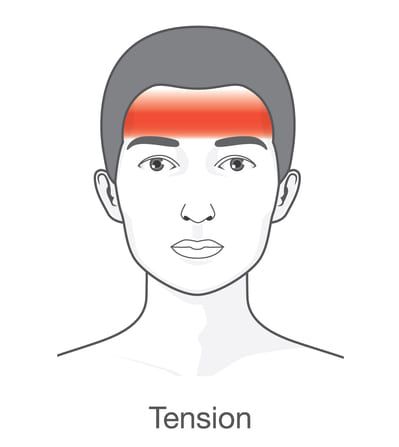
Tension headaches can be chronic and are also a common type of headache. These may cause mild, moderate, or intense pain behind the eyes, in the head, and neck. They can be described as a tight band feeling around the forehead as well. Most people who experience tension headaches have episodic headaches that occur on average one to two times per month. The causes of these headaches are due to muscle contractions in the head and neck regions, which may be from a variety of foods, activities, and or stressors.
Some people that endure tension headaches might experience them after staring at a computer screen for long periods or even after driving for extended periods. For other people, cold temperatures may trigger a tension headache. Other triggers for this type of headache include alcohol, eye strain, dry eyes, fatigue, smoking, a cold or flu, sinus infection, caffeine, poor posture, emotional stress, decrease in water consumption, inadequate amounts of sleep, or skipping meals.

Considering tension headaches are commonly caused by specific triggers, it is important to try identifying what is causes these headaches to prevent future episodes. Starting a headache journal may help to determine causes. Document daily meals, beverages, activities, and any circumstances triggering stress. Each time you have a tension headache, document this and after a few weeks or months, you should be able to notice a common denominator to determine what is triggering your tension headaches.
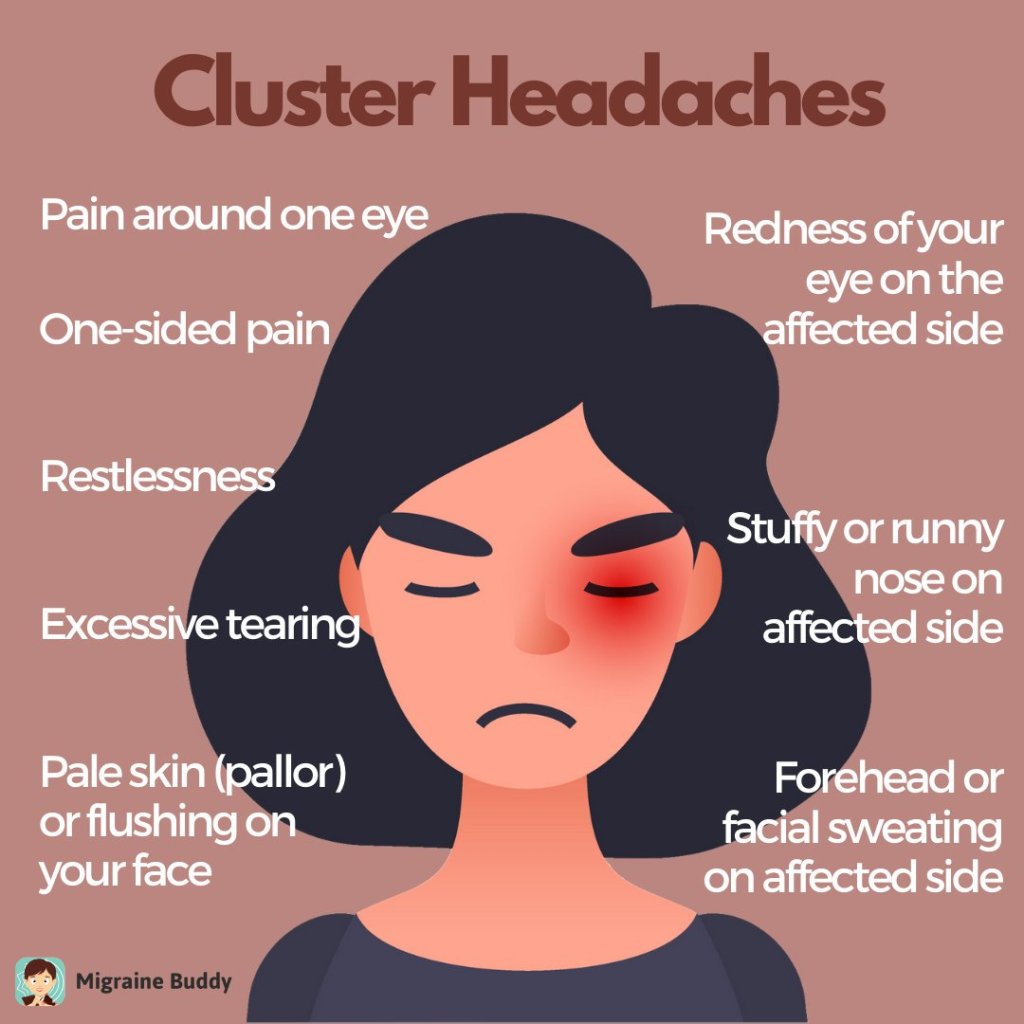
Cluster headaches are distinguished by an extreme burning and piercing pain, which typically occurs around or behind one eye or on one side of the face at a time. Swelling, redness, flushing, or sweating commonly occurs on the side that is affected by the headache. Sometimes nasal congestion and eye tearing will occur on the same side as the headache.
Cluster headaches are three times more common in men than in women. They generally occur in a series; each headache can last between 15 minutes and up to three hours. Many of those dealing with this type of headache experience one to four headaches a day, typically around the same time each day during a cluster. Once one of the headaches is resolved, another will follow soon afterward. The series of cluster headaches can be daily for months at a time. During the months between the clusters, the individual will be completely symptom-free. These are a lot more common during the spring and fall seasons.
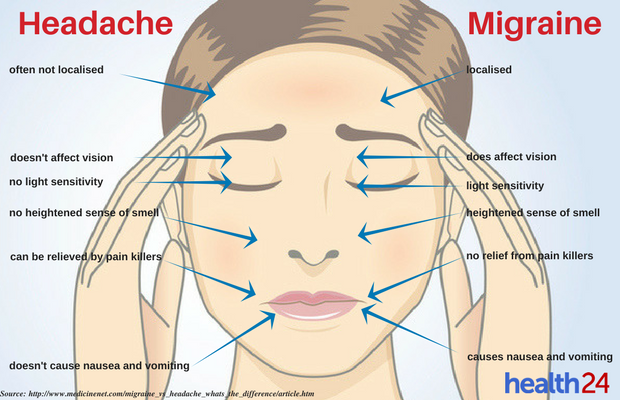
The pain from a migraine is a serve pulsing from deep within the head that can last for days at a time. These headaches can dramatically impact and limit the ability to carry out normal daily routines and activities. The throbbing sensation from a migraine is usually on one side of the head at a time. Those that have migraines are normally sensitive to light and sound. Also, nausea and vomiting may accompany a migraine. Approximately one out of five people with migraines have something known as aura before a migraine starts. Aura can cause people to see flashing or shimmering lights, zig-zag lines, stars, and or blind spots. This can also include tingling on one side of the face or in one arm, and difficultly speaking.
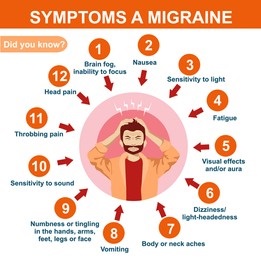
Migraines can run in the family or be associated with other nervous system conditions. Unlike cluster headaches, women are three times more likely than men to experience migraines. Unfortunately, people with post-traumatic stress disorder have an increased risk for migraines. There are certain environmental factors, such as sleep disturbances, dehydration, missing meals, some foods, hormone fluctuations, and exposure to certain chemicals that are the most common migraine triggers.
The following are the most common and effective ways to reduce migraine attacks:
1. Getting sufficient amounts of sleep. According to the US Centers for Disease Control and Prevention, most adults need seven to nine hours of sleep each night. Sleep allows our brain to calm and reset. While we sleep, there are chemicals released causing cortisol and adrenaline to back down.
2. Eating regularly with small portions throughout the day acts as a hunger preventative.
3. Monitor your caffeine intake. Some people may experience rebound headaches, which will be explained further in this post, from too much caffeine or withdrawal from it.
4. Stress is one of the most substantial triggers for a migraine attack. Taking time to relax and unwind can be incredibly beneficial and stop a migraine before becoming unbearable.

Secondary headaches are headaches that are caused by underlying medical conditions, such as a neck injury or a sinus infection. These are ongoing and may become a chronic issue. By treating the main cause of the headache, people will typically have headache relief. The following are types of secondary headaches:
Allergy or sinus headaches are due to an allergic reaction to something. The pain these headaches cause tends to be focused in the sinus areas and the frontal areas of the head. Those that endure chronic seasonal allergies or sinusitis are prone to these headaches. At least 90% of sinus headaches are in fact migraines that are commonly misdiagnosed.
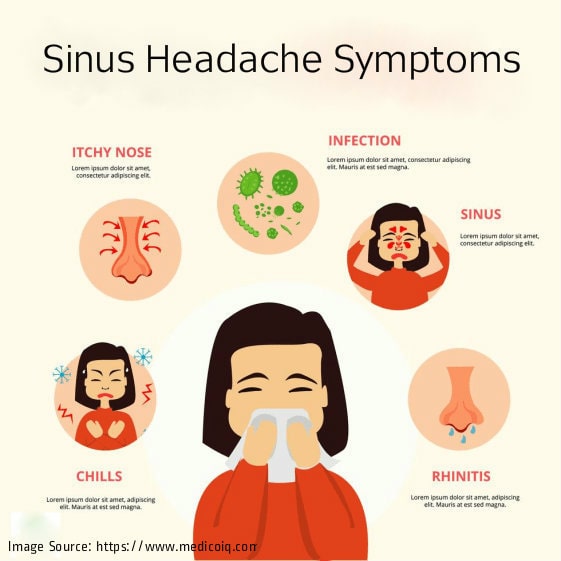
The way sinus headaches are treated is by thinning out the mucus that built up causing sinus pressure. There are nasal steroid sprays, over-the-counter decongestants, and antihistamines that can help clear up the issues. Some may require a visit to the doctor’s office to get an antibiotic to help clear the infection and alleviate the headache and any other symptoms that might be felt.
Hormone headaches are something that women commonly experience and are often due to hormonal fluctuations. Things like menstruation, birth control, and pregnancy can affect estrogen levels and cause headaches. These headaches may occur right before, during, or right after menses, as well as during ovulation. On average, about 60% of women experience this type of headache. There have are other types of remedies discovered that may help decrease the amount of these headaches each month, which may include relaxation techniques, yoga, acupuncture, and eating a different type of diet.

Caffeine headaches, whether it be too much or quitting cold turkey, caffeine can contribute to headaches. Caffeine affects the blood flow to the brain, which creates several problems besides a nasty headaches. Anyone that has frequent migraines is at risk of triggering headaches due to their caffeine intake. Many people are used to a certain amount of caffeine each day, which acts as a stimulant, caffeine, and or withdrawal from it can trigger headaches.

Exertion headaches occur quickly after times of intense physical activity. Some of the most common triggers for this type of headache are weightlifting, running, and sexual intercourse because they cause increased blood flow to the skull and can induce a throbbing headache on both sides of the head. These headaches do not typically last long like many others do and will improve between a few minutes to several hours.
Hypertension headaches are due to high blood pressure and may indicate an emergency if blood pressure becomes dangerously high. This type of headache tends to occur on both sides of the head and will get worse with any activity. Those experiencing this form of headache may have vision changes, numbness or tingling, nosebleeds, chest pain, or shortness of breath. Once the blood pressure is under better control, the headache will also go away.

Rebound headaches can feel like a dull, tension-type headache, or be more extreme and intense pain, like that of a migraine. This type of headache is also referred to as medication overuse headache due to using over-the-counter pain relievers too frequently. Many people use over-the-counter medications such as acetaminophen, ibuprofen, aspirin, and naproxen believing they will help to decrease their headaches, but often end up creating more when using these medications for more than 15 days out of the month. Rebound headaches occur most commonly with OTC medications that contain caffeine. The best way to avoid these types of headaches is to discuss with your doctor medication that works as a preventative for headaches and does not cause rebound headaches.

A post-traumatic headache will evolve after any type of head injury. This type of headache may feel like a migraine or tension headache and will typically last 6-12 months after the injury happened. A few of the most common symptoms include dizziness, insomnia, difficulty concentrating, memory issues, sensitivity to light and sound, mood, and personality changes. Post-traumatic headaches may become chronic. Several treatments that may help to help this type of headache improve including physical therapy, occupational therapy, speech therapy, relaxation therapy, nerve stimulation, and cognitive behavioral therapy.

Thank you for visiting my site today. I hope the information I have shared with you was helpful for you or someone that you know. I know that dealing with headaches is not pleasant or easy, but we can find ways to get through them. If you have any other ways to deal with any type of headache, please share because I know it will help someone that is reading. I hope you have had a great and relaxing weekend and you are ready for the week to begin again tomorrow. I hope you never forget that I am always sending y’all LOT of love, comfort, support, and MANY positive vibes!

Always, Alyssa

Reblogged this on Survivors Blog Here Mental Health Collaborative .
LikeLike
I deal with headaches and migraines. Some are with auras. It sucks – im constantly looking for relief and recently started increasing my water intake thinking that would help. It worsened my migraines. I’m hypo-natremic so I’m told to take sodium. The extra water probably diluted my already low sodium levels. I’m hoping that electrolyte tablets help with sodium balance. Headaches and migraine pain I wouldn’t wish on anyone.
LikeLiked by 1 person
I completely understand always looking for relief. I do agree with you about increasing water intake because I have heard and from my own experience learned that increasing it helps a lot. I am right there with you and would not wish these headaches on anyone.
LikeLiked by 1 person
so very sorry that you live with headaches too………….the ones that drag on for days on end are so very awful.
LikeLiked by 1 person
Thank you, Wendi. It is not fun, but I guess it is just life. I think this one that lasted 6 days was the longest I have ever dealt with one.
LikeLiked by 1 person
so sorry…………they totally suck!
LikeLiked by 1 person
Yes, ma’am they definitely do!
LikeLiked by 1 person